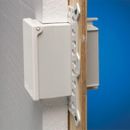Exterior Electrical- Arlington Box Flashing
I’m looking for some advice on flashing/water prevention measures on an exterior electrical outlet with rainscreen. It’s B&B siding. I see plenty of way to flash the box or wire penetration to the WRB, but the siding to box bit is where I lose it.
If one takes the Arlington INbox approach, and uses the box for foam assemblies (see image) it appears the box protrudes through the siding. So how would one weather seal that protrusion? Just silicon/sealant between the box and siding?
I know folks regally mention mounting blocks (and flashing the mounting block) but in the case of the Arlington one-piece box, there would still be that gap between the mounting block and box. Just seal it?
The other approach: If I use a separate electrical box and cover, should the gasket seal against the siding/mounting block, or the electrical box face itself? My understanding is the seal is made against the siding, but then there’s a gap between the electrical box and the cover immediately behind the face of the siding. It seems that gap is just waiting for water to enter if it makes it past the siding seal? (And with rough hemlock siding, I am reluctant to trust that seal over time). Am I missing something here
GBA Detail Library
A collection of one thousand construction details organized by climate and house part










Replies
> I see plenty of way to flash the box or wire penetration to the WRB, but the siding to box bit is where I lose it.
Is the issue that, because siding is fully installed, you have no means to flash to the WRB? Just want to make sure I'm understanding the question correctly...
Patrick,
I'm sure I'm overthinking it... I just want to be sure I understand the typical detail.
The siding is already installed, but I will have to strip off two battens and a board either way to install the box (siding is screwed). I can flash the back of the box, or the wire penetration if surface mount, to the WRB, but that doesn't do anything to keep water (or insects for that matter) from entering the gap between the siding (1" thick hemlock board) and the side of the box.
Arlington seemingly neglects to show any finished images for the foam wall version (in fact, I see no way siding could be integrated to the box the way it's shown in their image. The box face is too far recessed to accommodate the thickness of siding). I imagine it's just a matter of a bead of sealant, but I want to be sure I'm not missing something.
I suppose I can see how a mounting block allows for cap flashing to kick water off the wall that may be running down from above, making the gap between the box and the block/siding not as crucial. Either way, I'm curious how that gap get's handled.
Tyler,
Whether it's through the siding, or a mounting block, the electrical box just gets caulked to whatever surrounds it.
Thanks Malcolm.
I usually use surface mount boxes and inset them into the siding/rigid. The wiring gets fed from the back through a loomex grommet, there is no need for a big hole in the wall or any flashing. The sides of and top is caulked. I've never put kick out flashing there but doesn't hurt, just make sure it doesn't interfere with the cover.
Yeah I was kinda leaning that way to avoid cutting the box into the sheathing.
In that case the weather proof box cover gets sealed directly to the electrical box, and not to the siding, correct?
Kinda wish there was a one-piece box like the Arlington, but not as deep so I could surface mount it.
Make sure your flashing allows for the possibility of water running out underneath the box. I've seen water sheet down the side of a building and get into similar boxes before. Usually the back of the interior has a lip to prevent the water from running back into the area where the electrical connections are, but the boxes tend to "focus" the water in the area immediately underneath the box. Basically don't just assume the only point water could sneak into your wall is the top and side areas of that box.
Bill